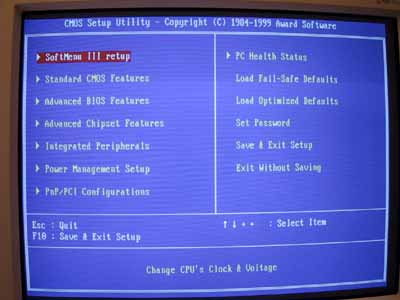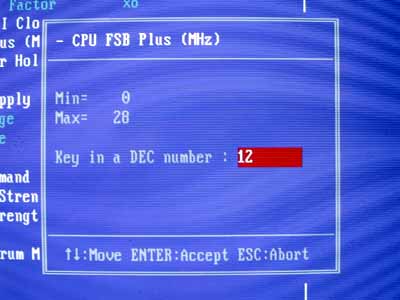ABIT has always been known for their SoftMenu jumperless CPU configuration utilities, and the KA7 does not stray from tradition as it features ABIT's latest SoftMenu III Jumperless CPU setup utility. The way the SoftMenu III setup on the KA7 works is that there are a number of selectable FSB frequencies, ranging from 100MHz up to 155MHz, and as you can tell by the specifications for the board, there are supposed to be options for 100 - 183MHz in 1MHz increments.

Instead of having a drop down of 83 FSB frequencies, ABIT features a handful of frequencies that can be selected as well as an option to increment the selected FSB frequency by a number from 0 - 28MHz. For example, if you selected the 100MHz FSB frequency, you could then go to a separate box and add 5MHz to it for a final FSB frequency of 105MHz. Or you could add 1MHz to a 110MHz FSB setting for a resulting 111MHz FSB frequency. Our KA7 was able to hit the 117MHz FSB frequency fairly reliably, but unfortunately, anything higher would not POST, but this has been the case with all Athlon motherboards we've encountered so there's no real surprise there. For those of you that would rather use dip-switches to adjust your FSB frequency, the KA7 does have a set of 8 dip switches for that very purpose (they are mainly there for OEMs).

The KA7's SoftMenu III setup also allows you to manually adjust the core voltage supplied to your CPU as well as the I/O voltage supplied to the rest of your motherboard The latter is selectable from a list of voltages ranging from 3.20v - 3.90v in 0.10v increments. In order to further tweak performance and stability, ABIT's SoftMenu III setup adds a few more options to the usual set of tweaking features, the ability to control the CPU Pull Up & Drive Strength Settings in addition to the CPU Command Decode waitstate. The first two options are mainly for tweaking the signal strength present between the 371 North Bridge and the CPU; the tradeoff that is made with those settings is performance vs. stability (clean signal). Those two options are mainly for the extreme hardcore tweakers, and most users will just want to leave them be.
As with all other KX133 based motherboards, the SoftMenu III setup allows for the selection of the memory bus clock. The difference between the way the KA7 lists the memory bus clock options and the way that all other motherboards do is that the KA7 actually tells you the truth about what each setting is actually doing. While all other KX133 boards simply list available memory bus clock options as FSB + 33MHz or FSB - 33MHz, the memory clock is actually derived by setting it equal to the FSB or equal to the FSB frequency - PCI bus frequency or the FSB freq. + PCI bus frequency, and that's exactly what the KA7 lists for the DRAM clock options: Host Clock, HCLK - PCI CLK and HCLK + PCI CLK.
ABIT bundled the usual external thermistor with the KA7 (they do this with all of their motherboards that feature external thermistor headers) and their classic ABIT User's Manual that is both easy to read and can be very useful for novices that may be a bit uncertain about some functions of their motherboard. Of course, the obligatory bundled drivers/utility CD is packaged with the motherboard as well.










0 Comments
View All Comments